Theory of English Grammar synopsis Final examinations ©

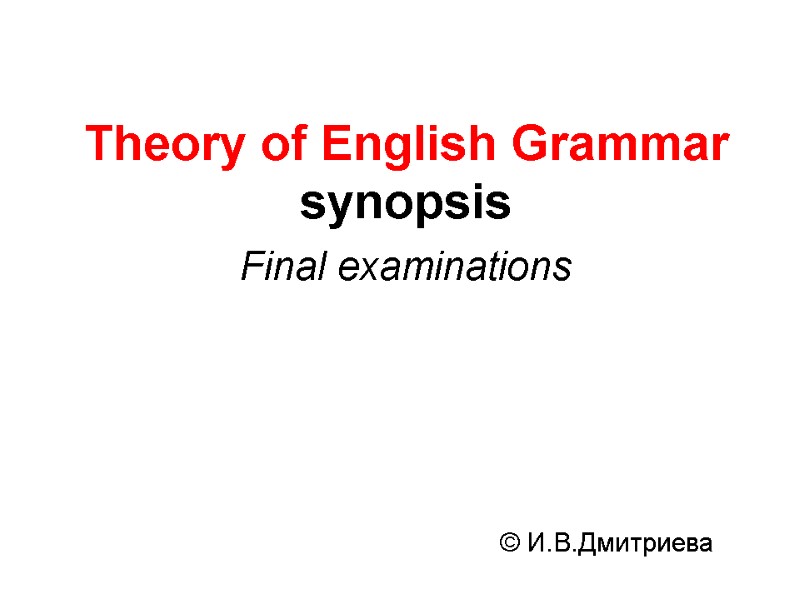
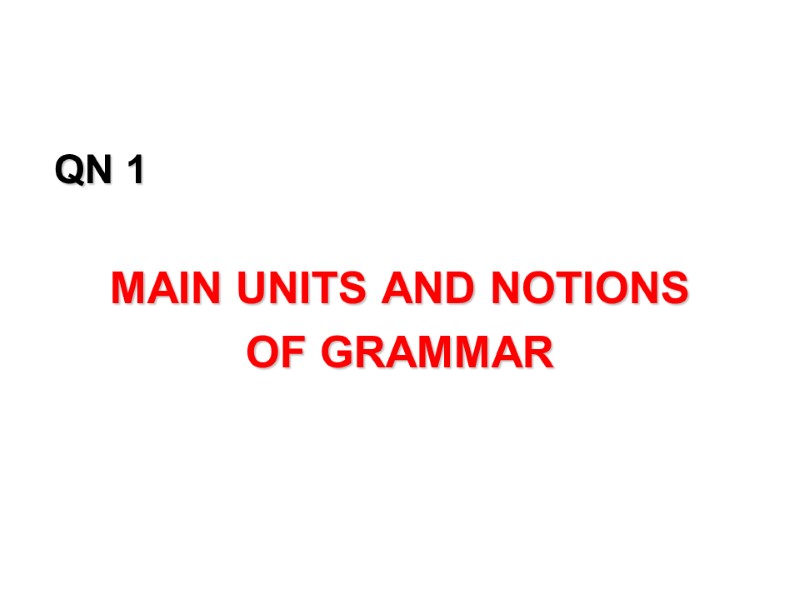
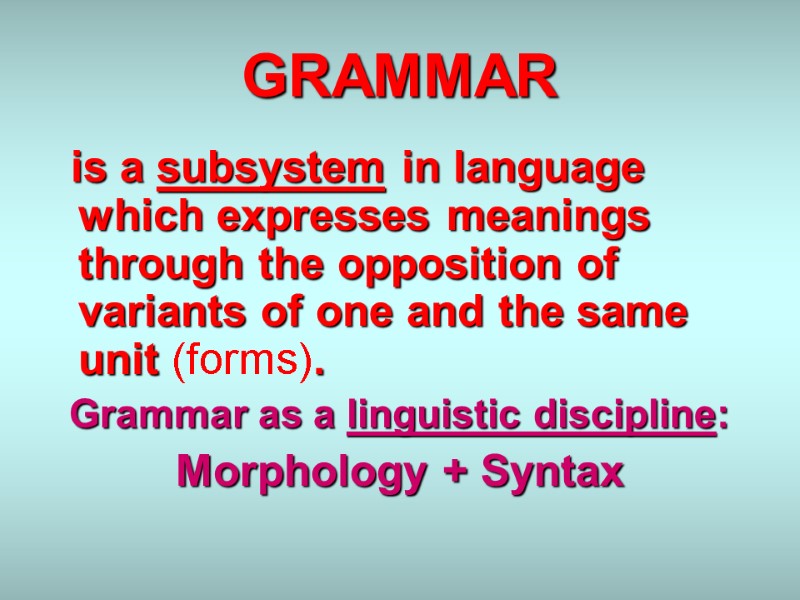
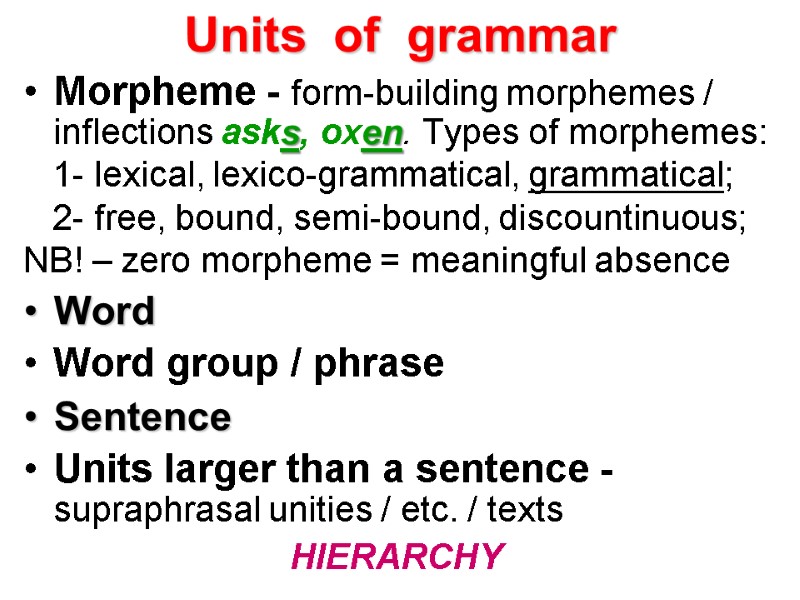
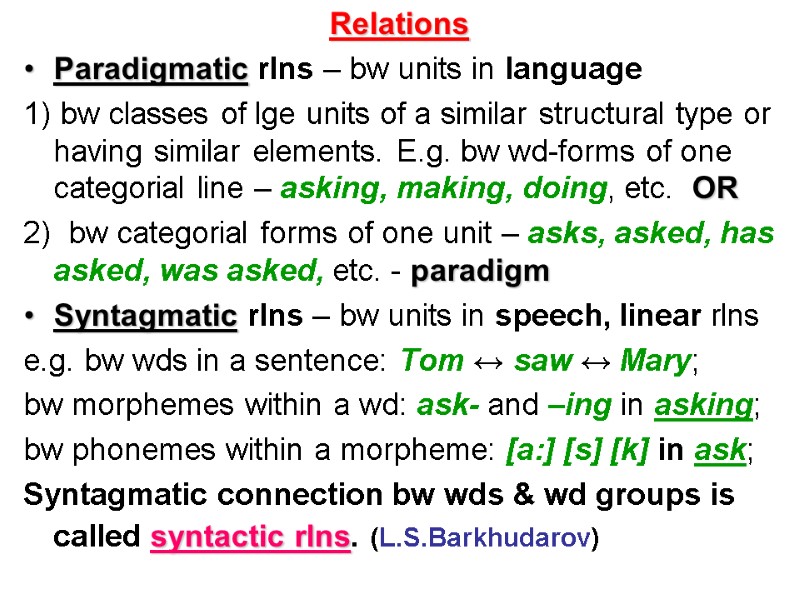
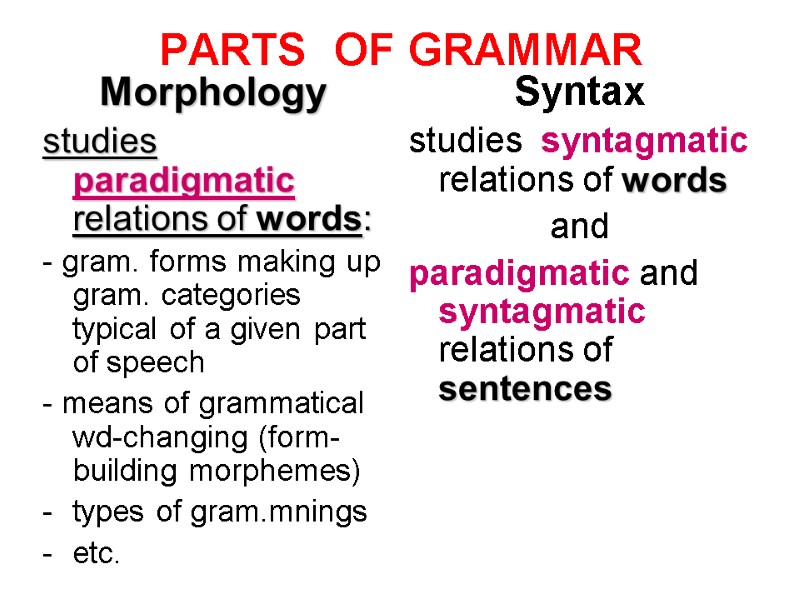
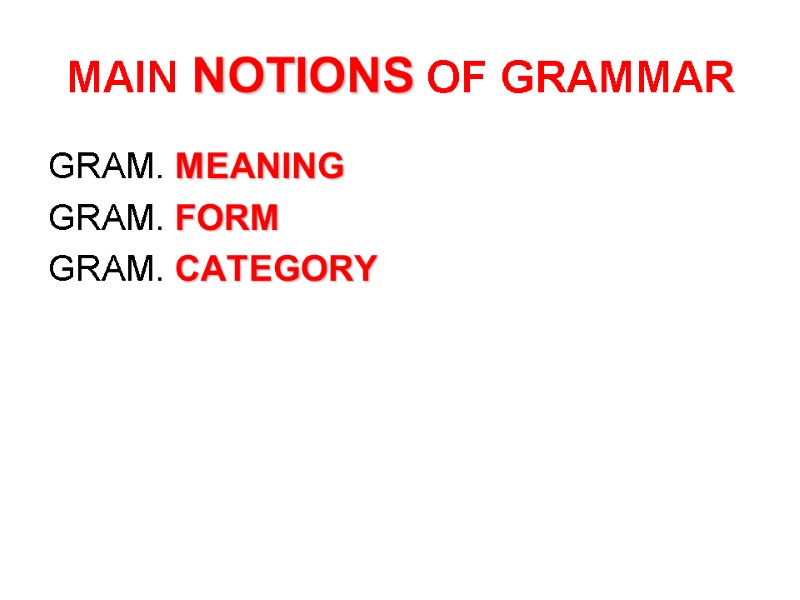
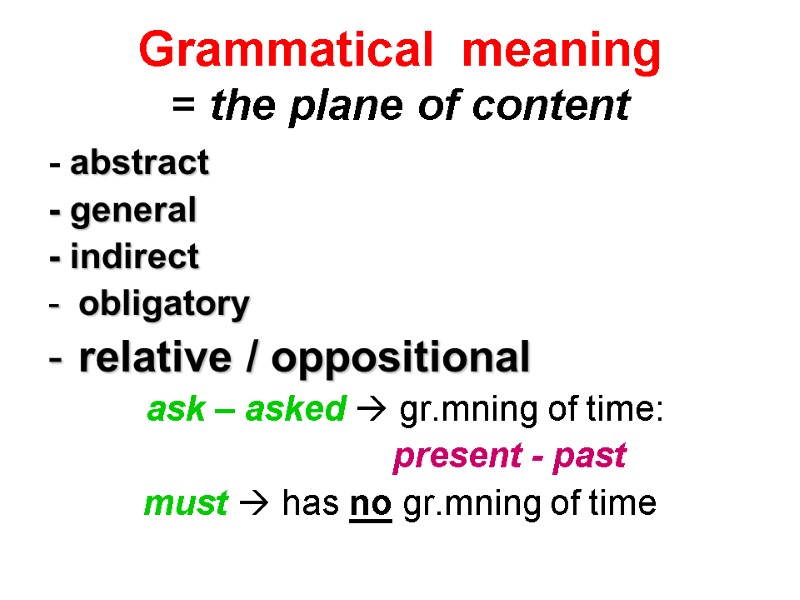
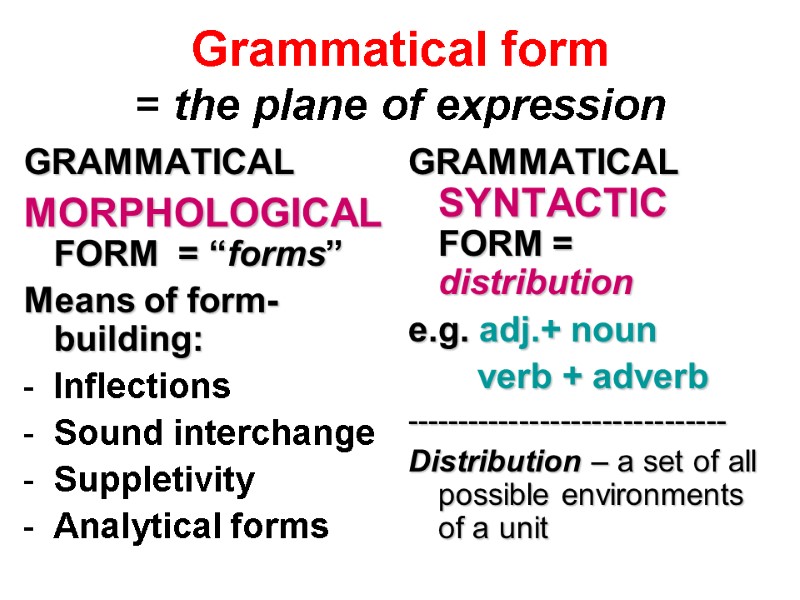
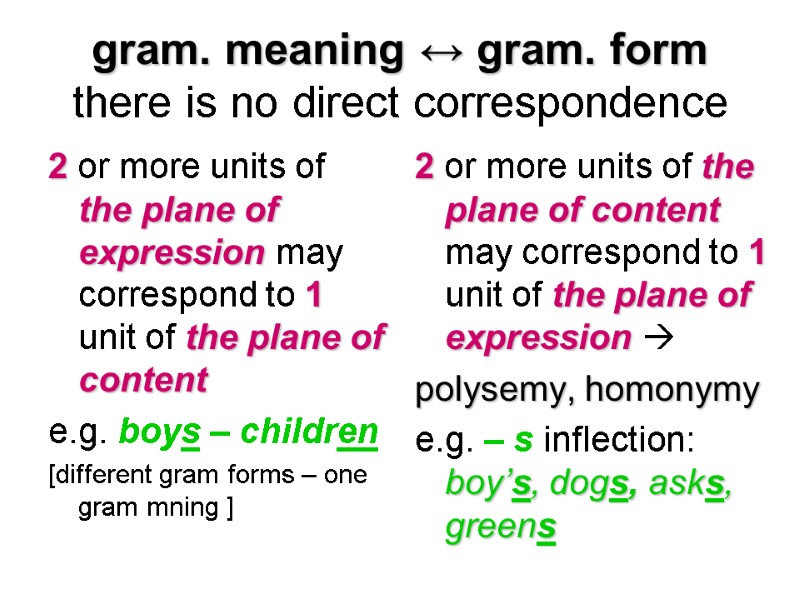

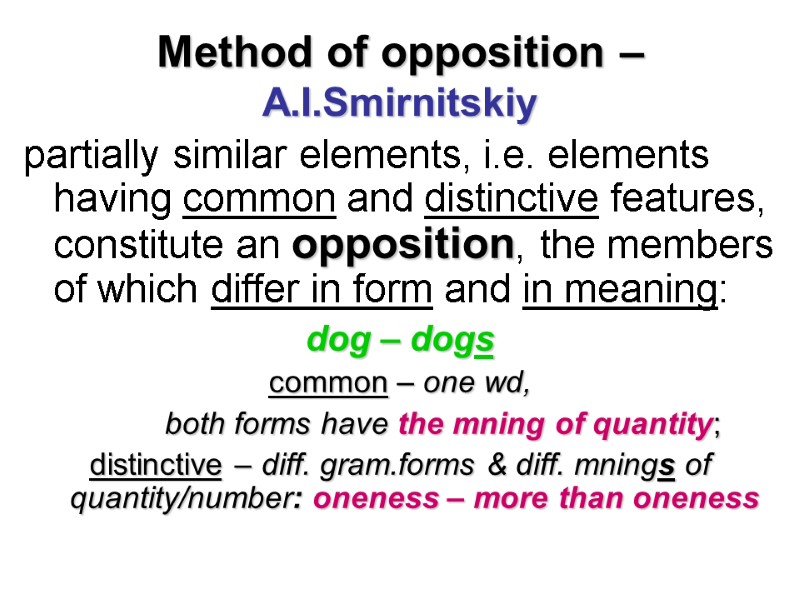
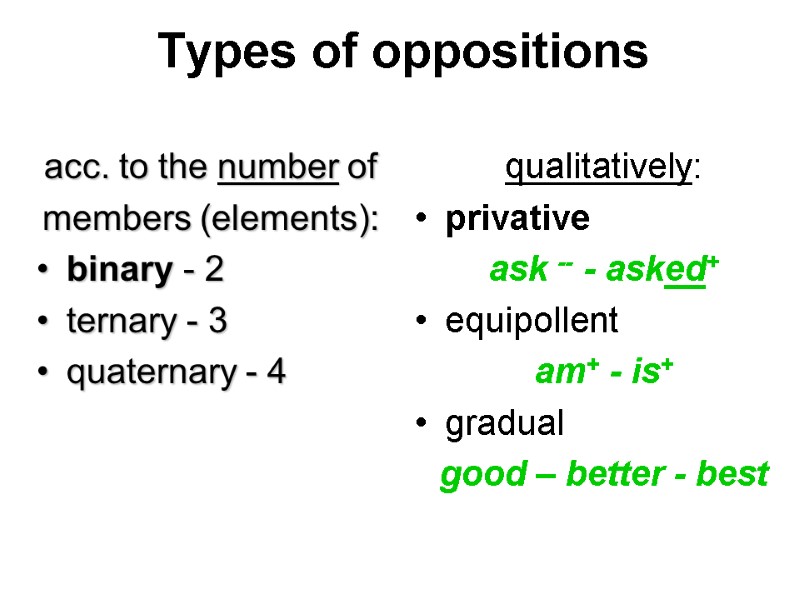
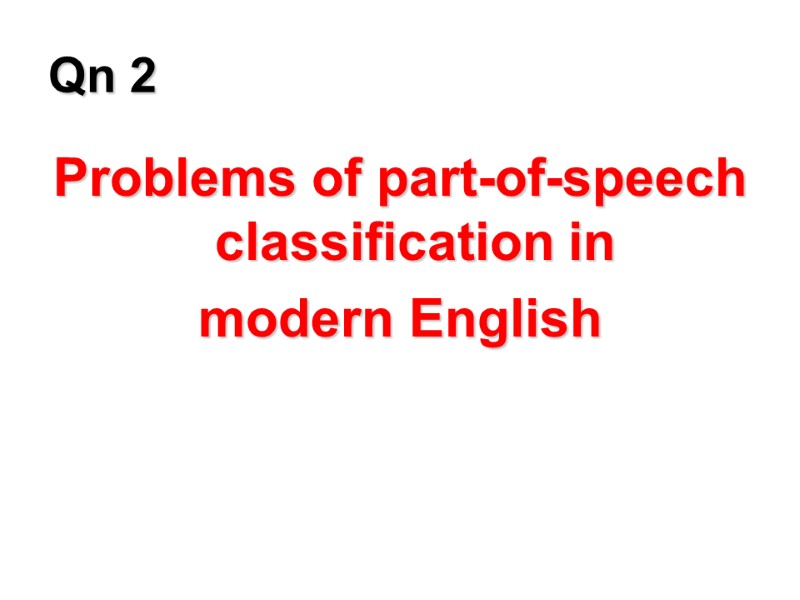

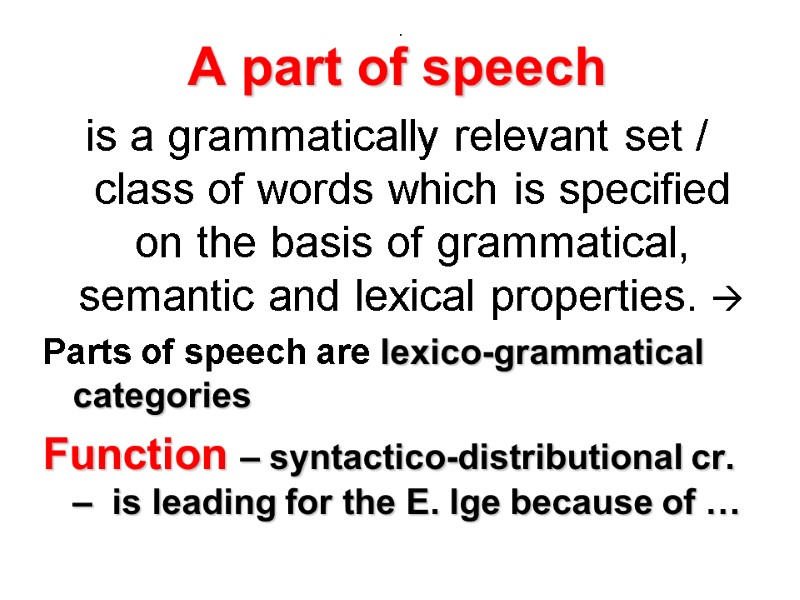
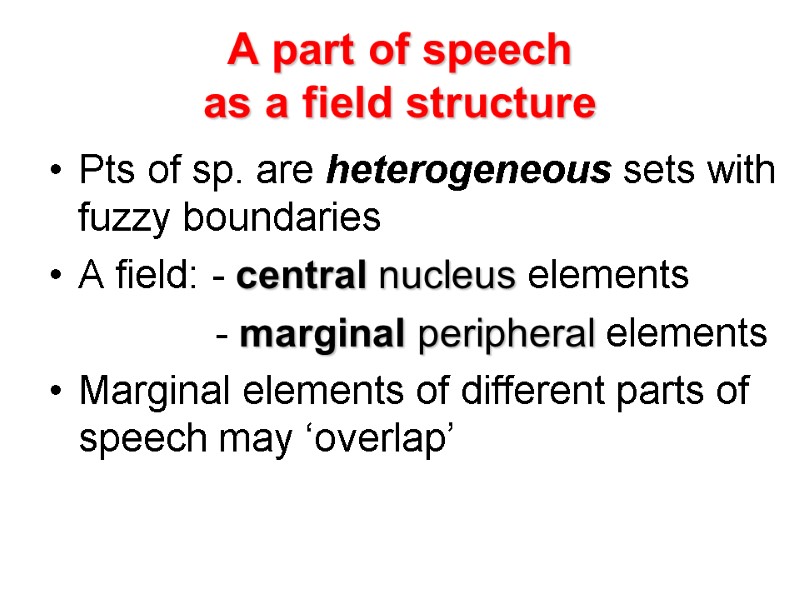
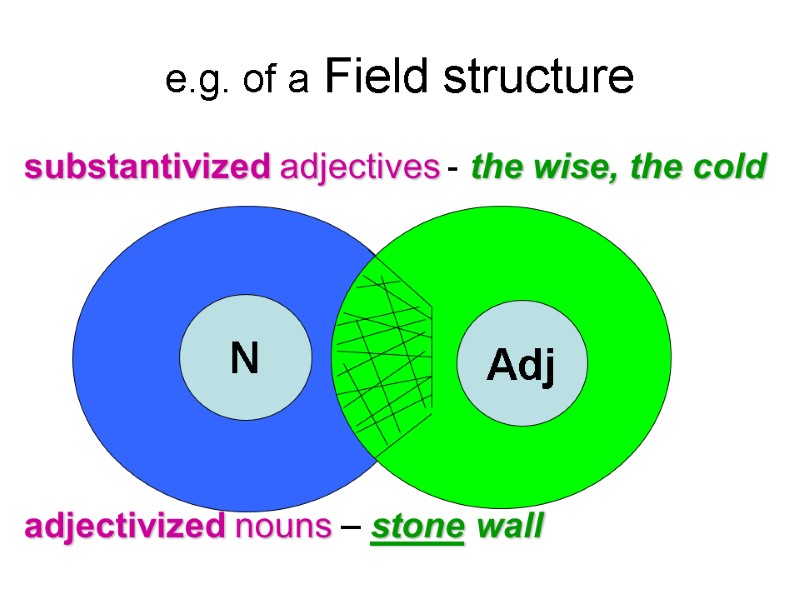
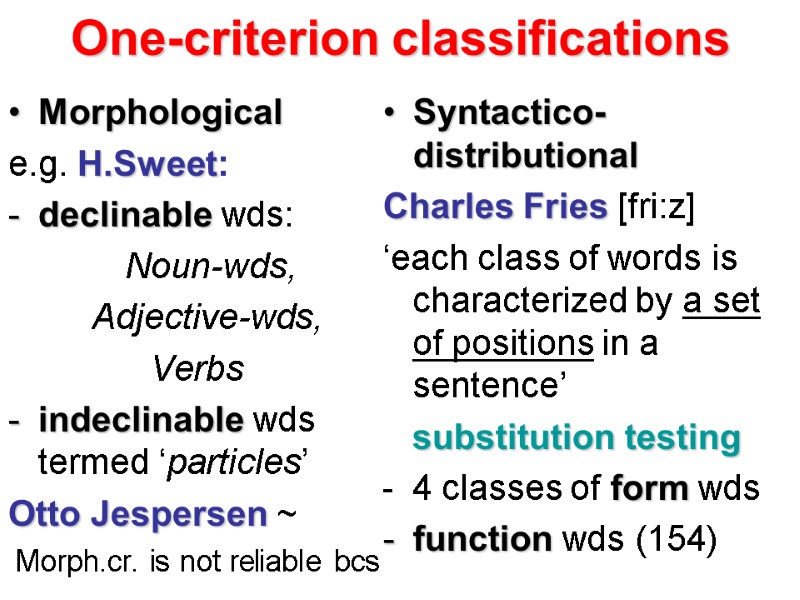
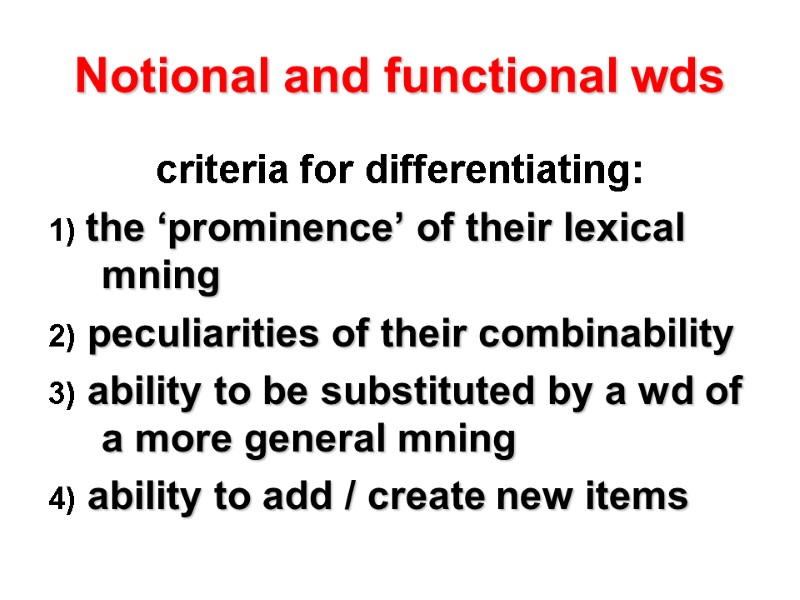
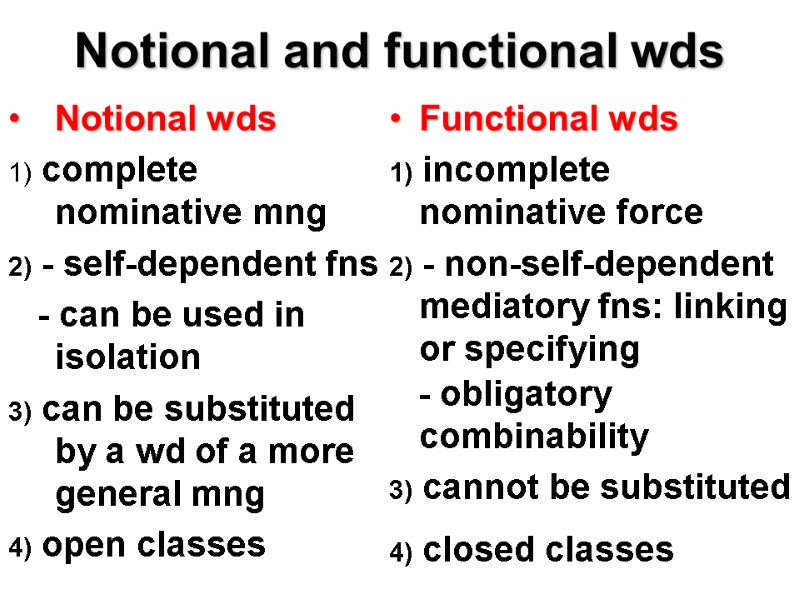
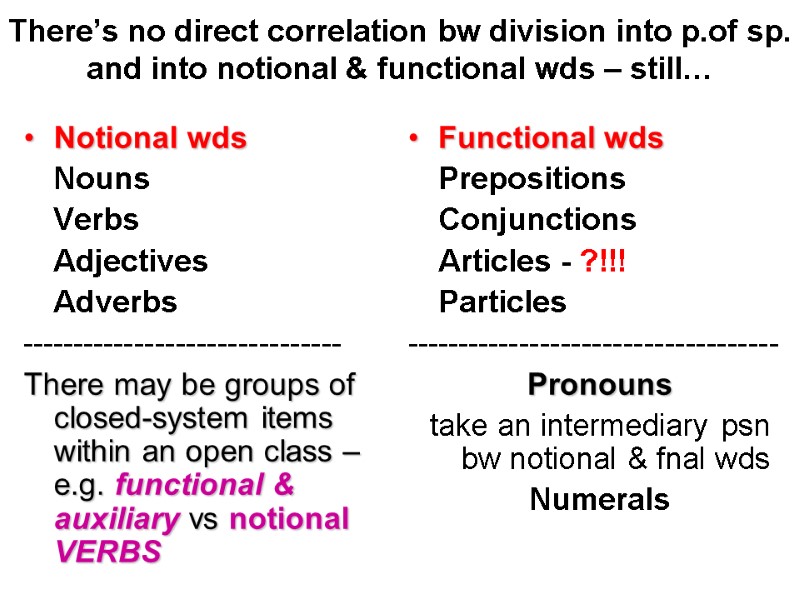
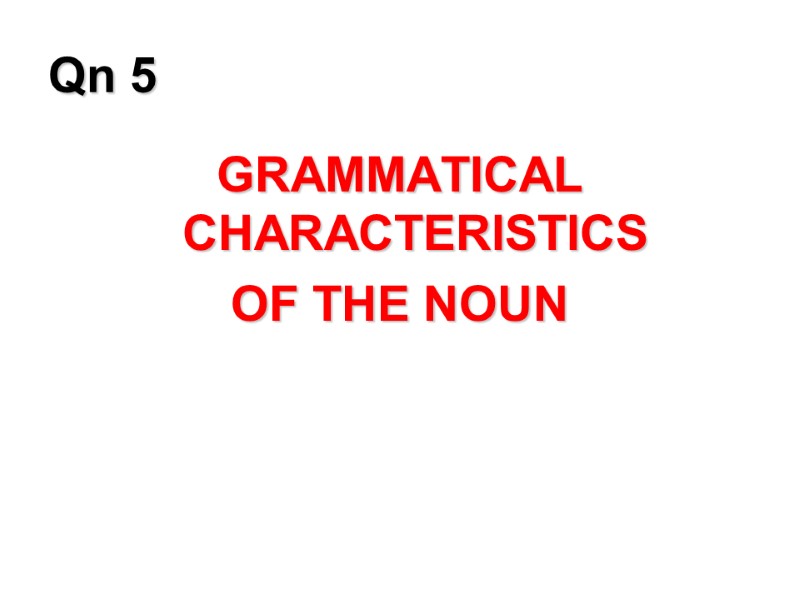
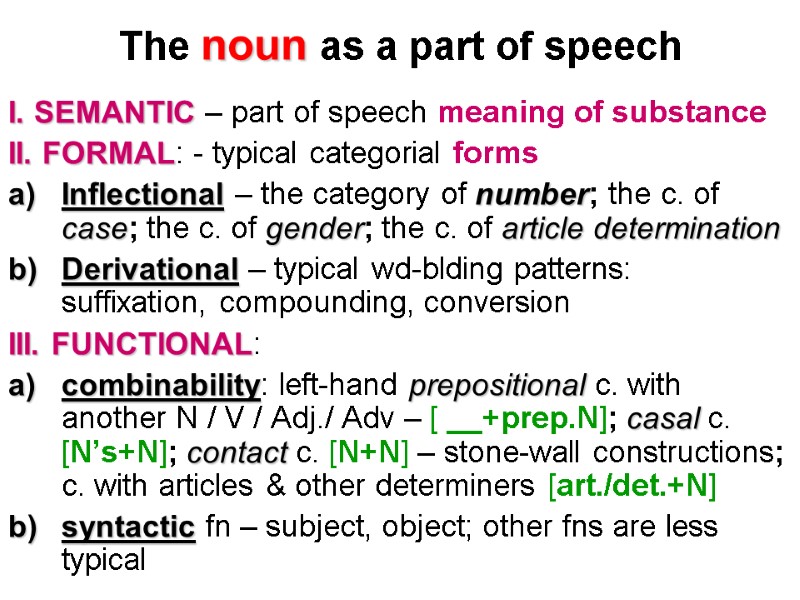
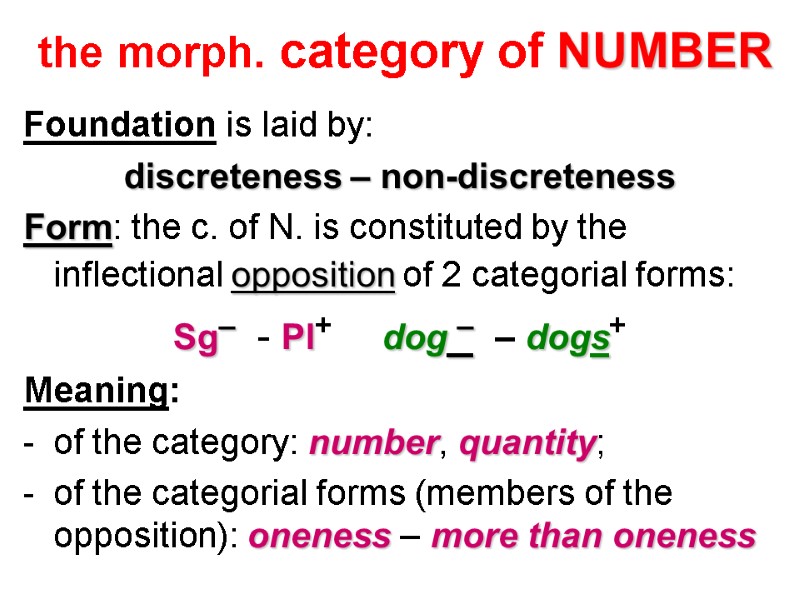
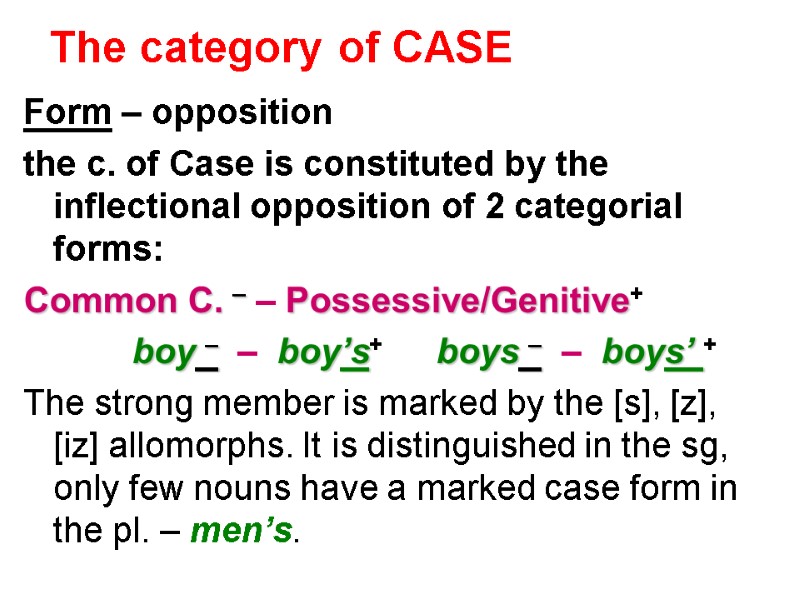
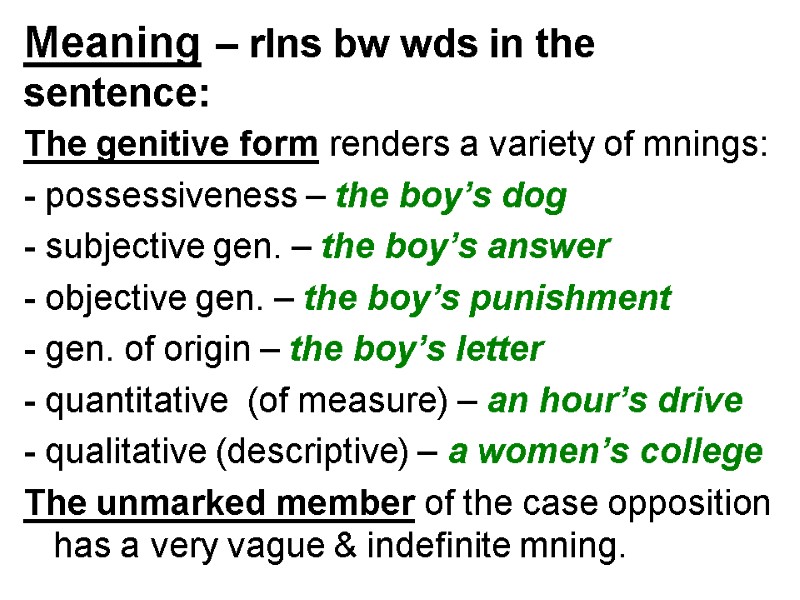

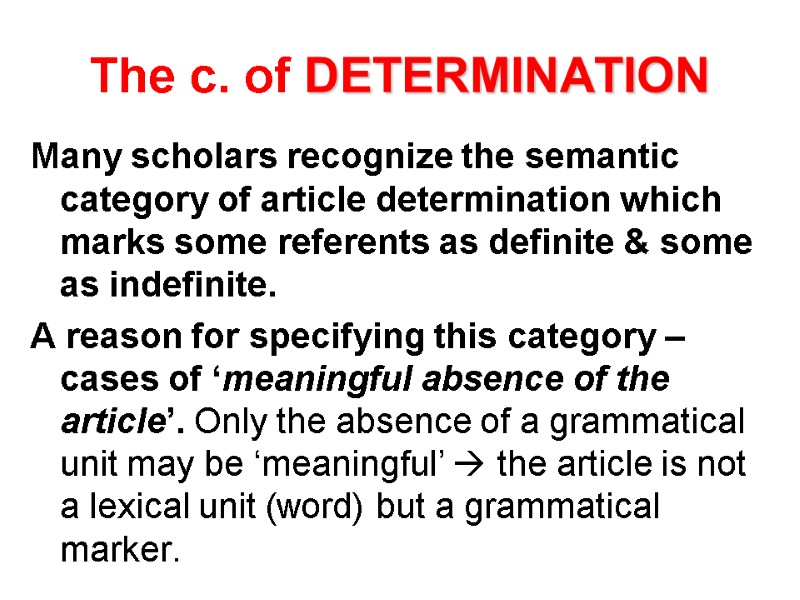
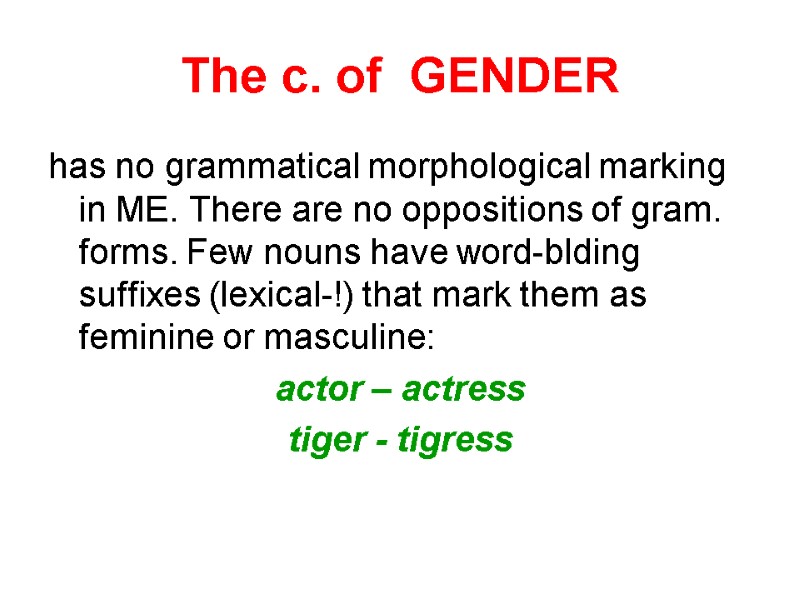
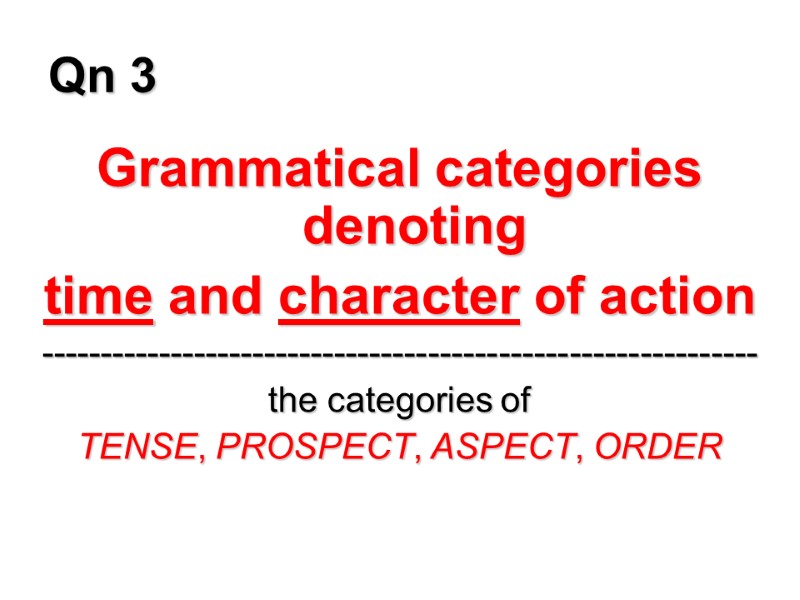
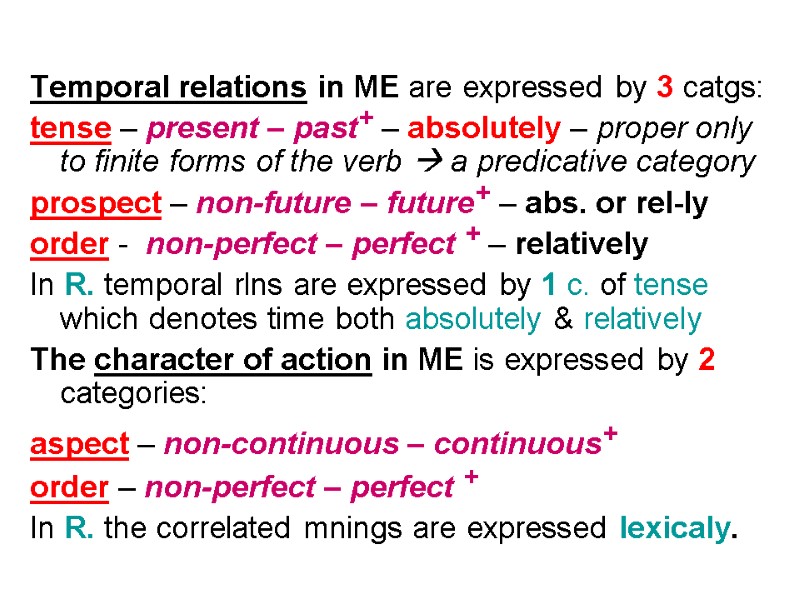

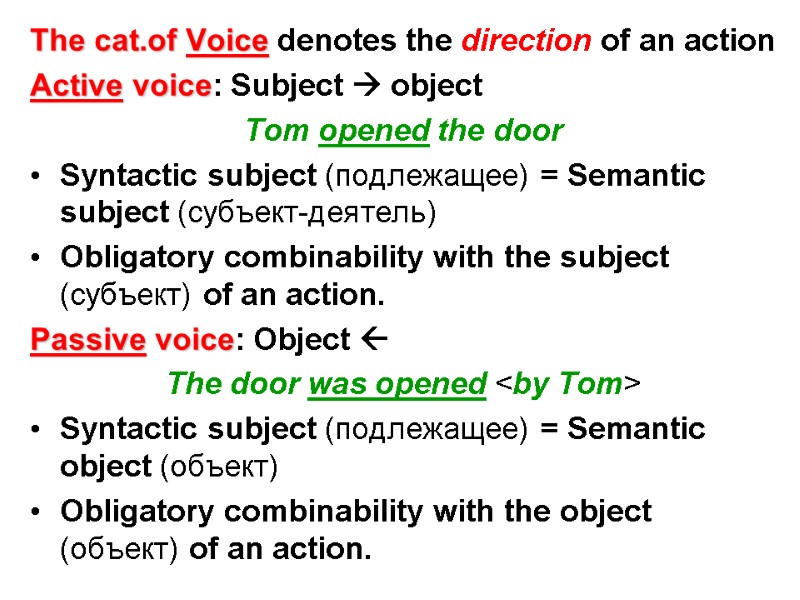
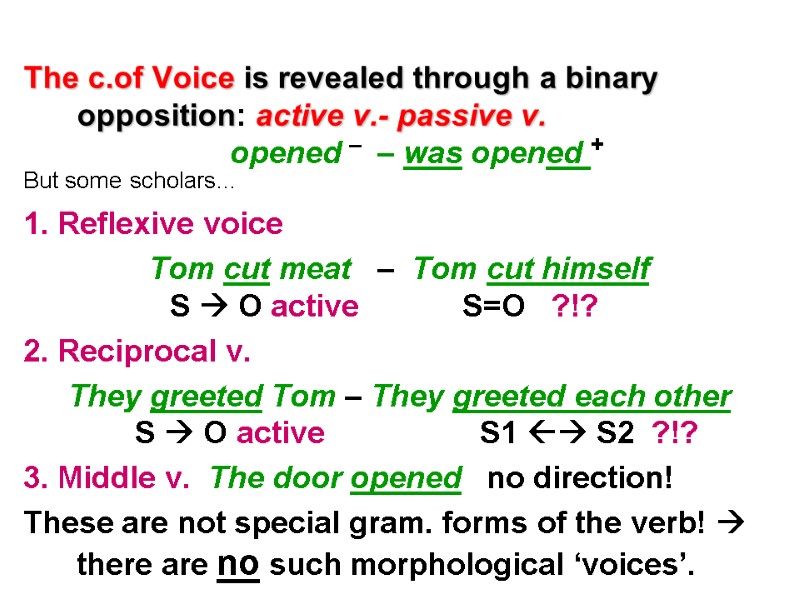
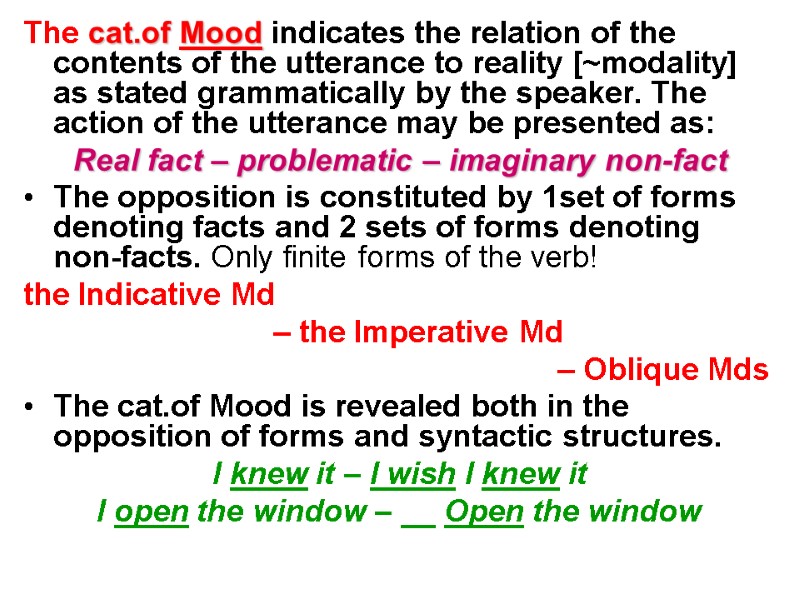
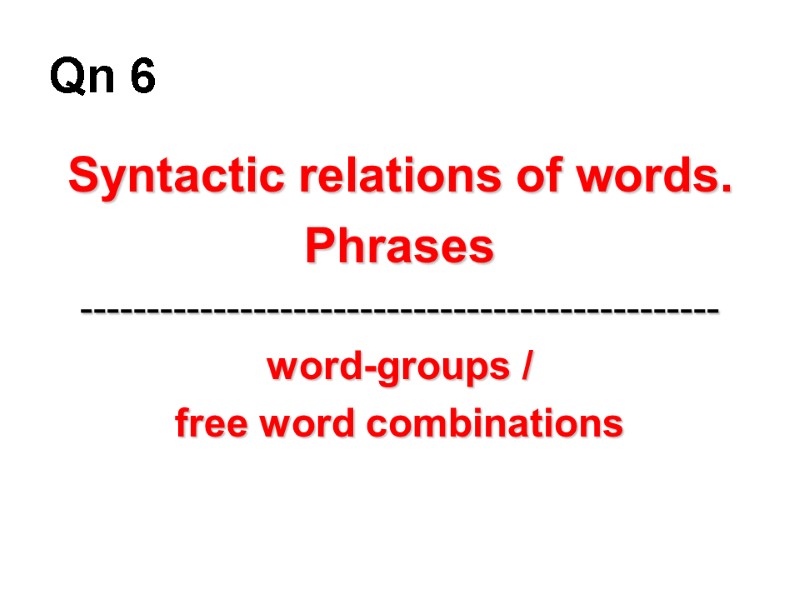
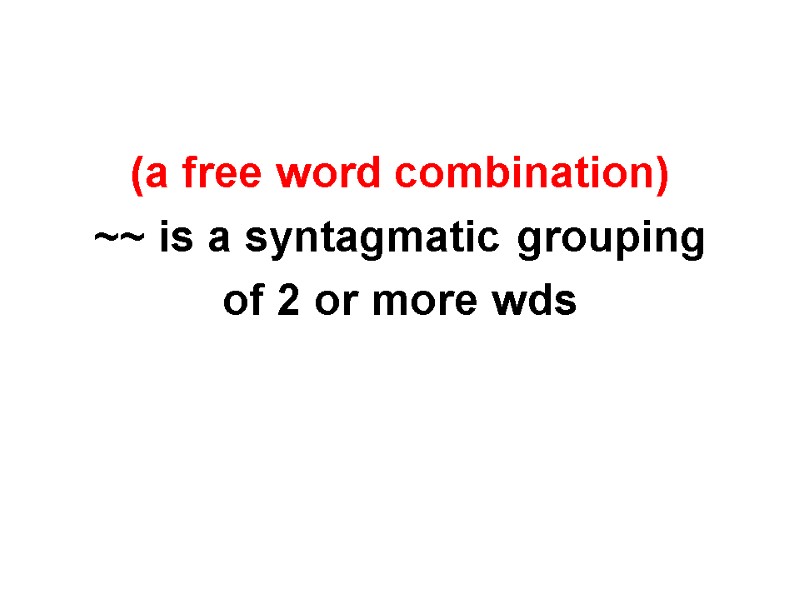
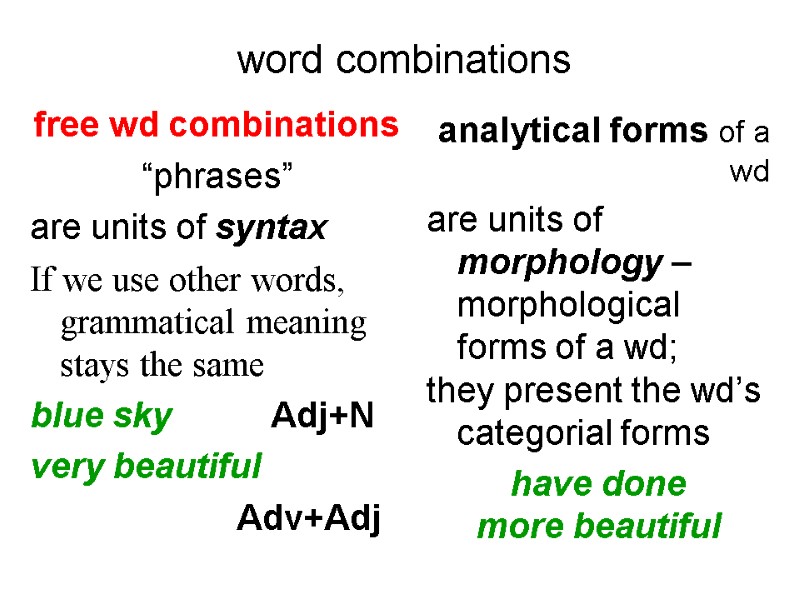
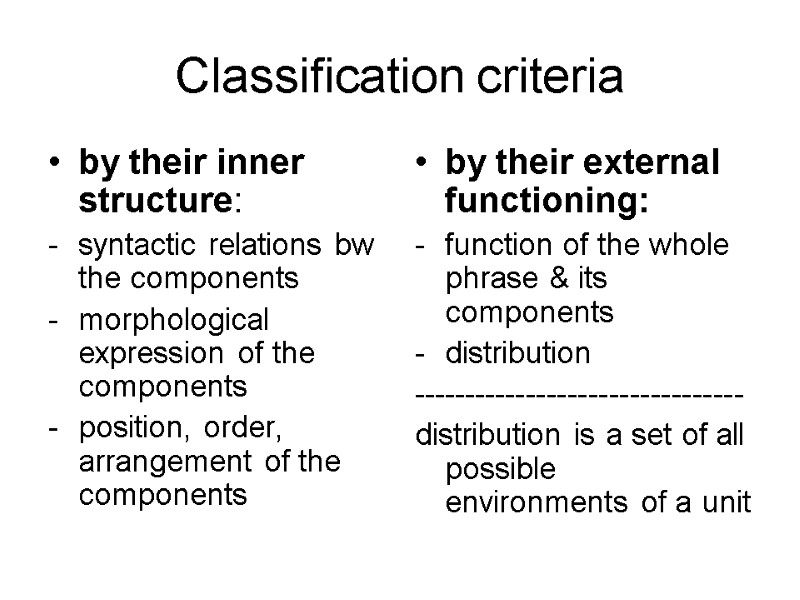
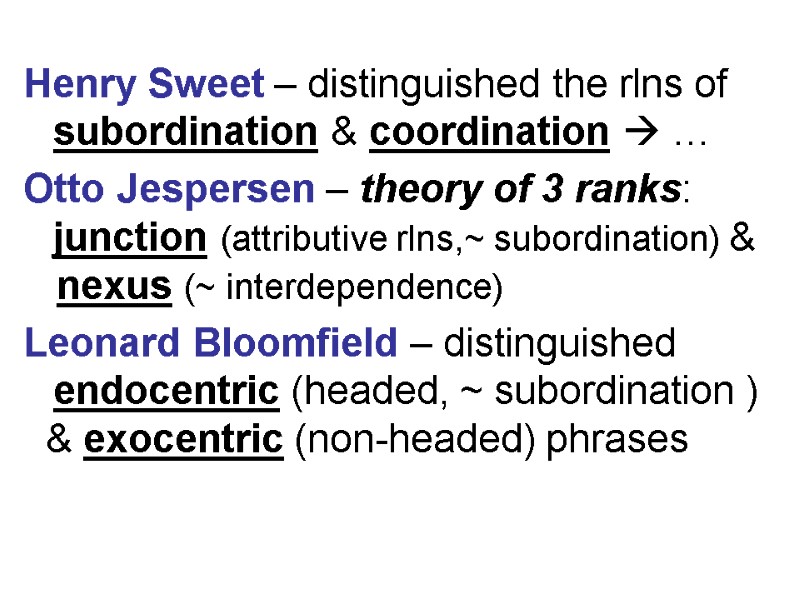
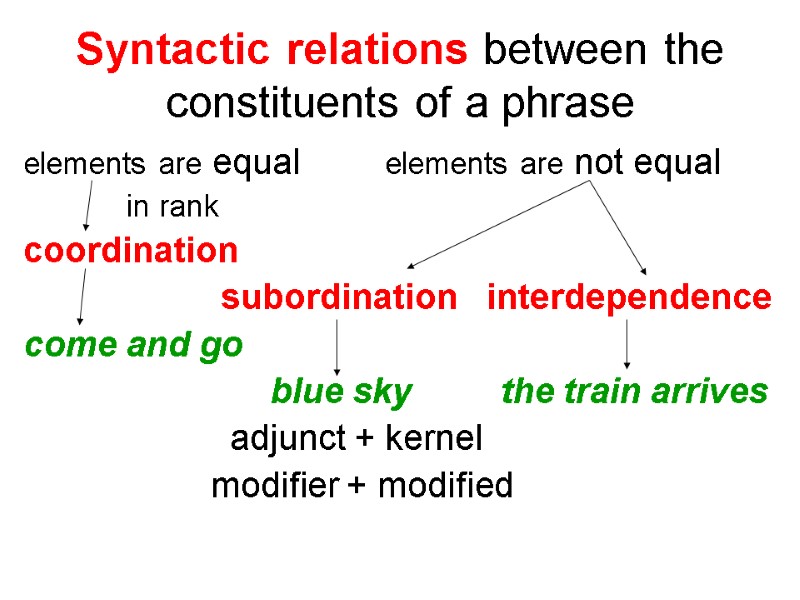
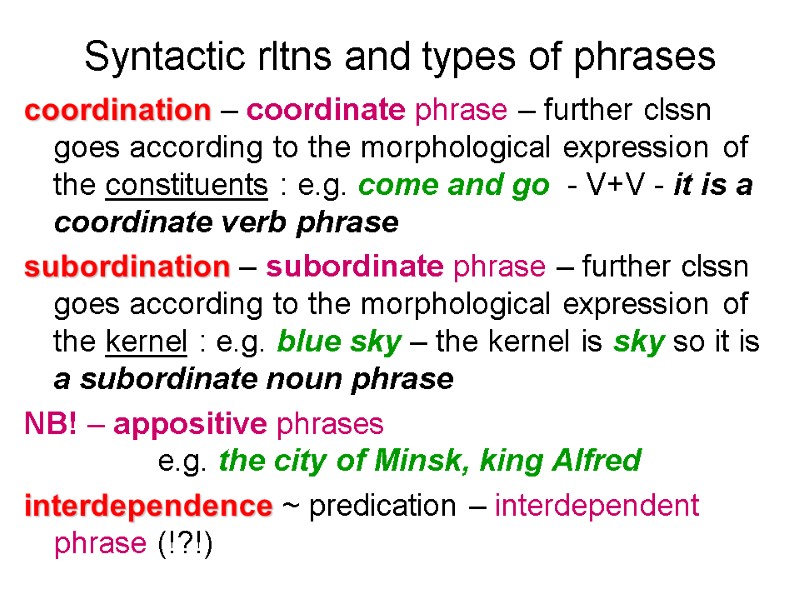
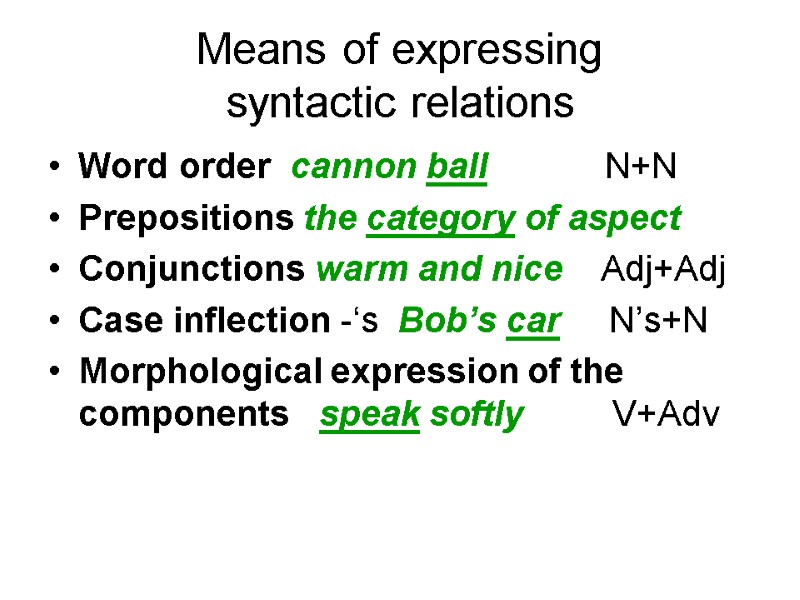

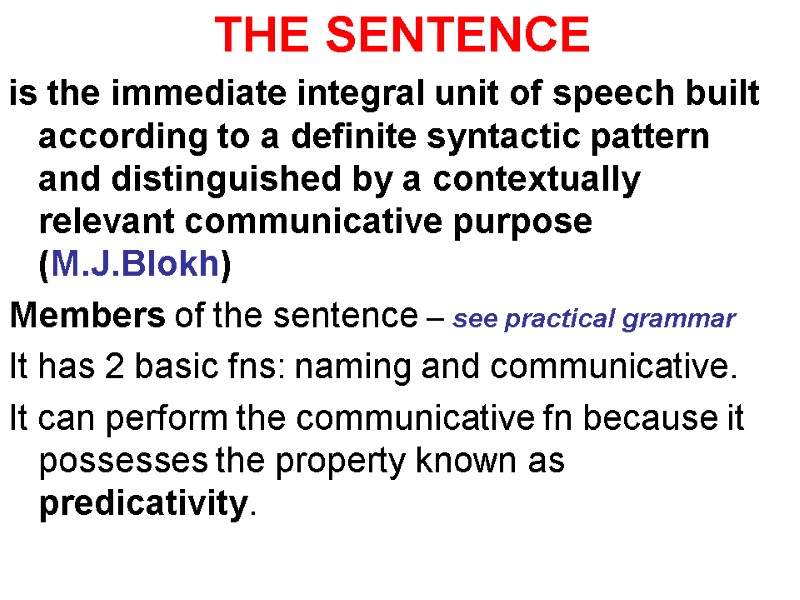
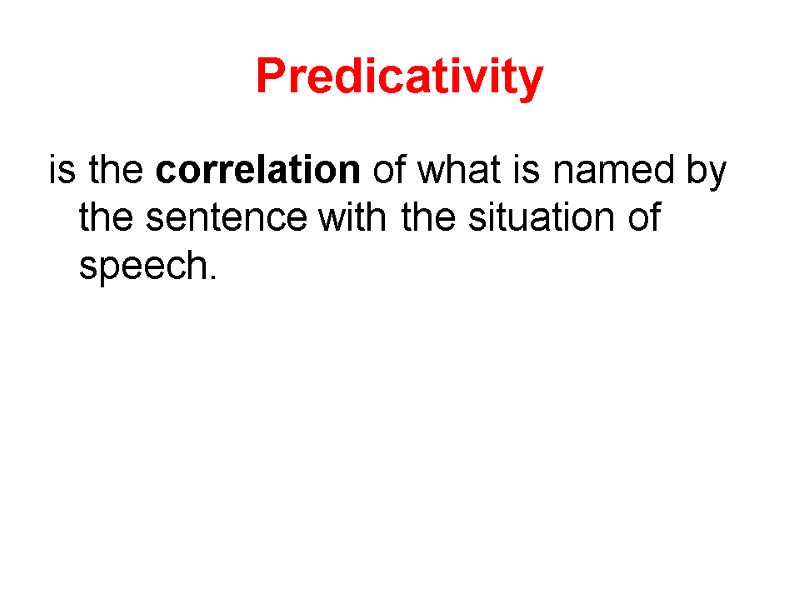
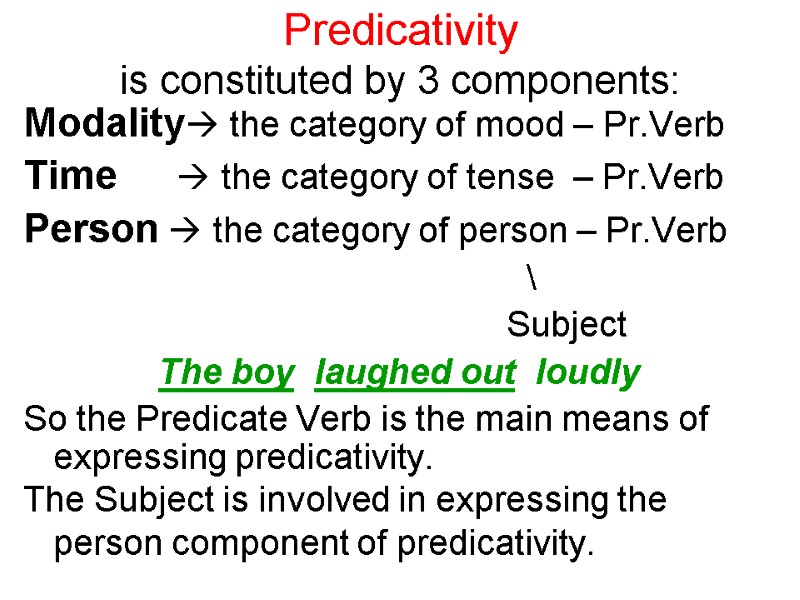
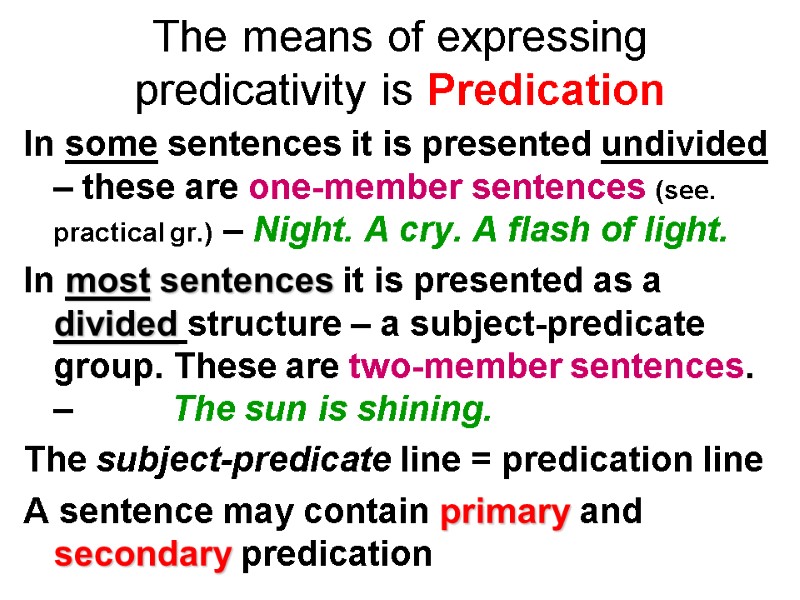
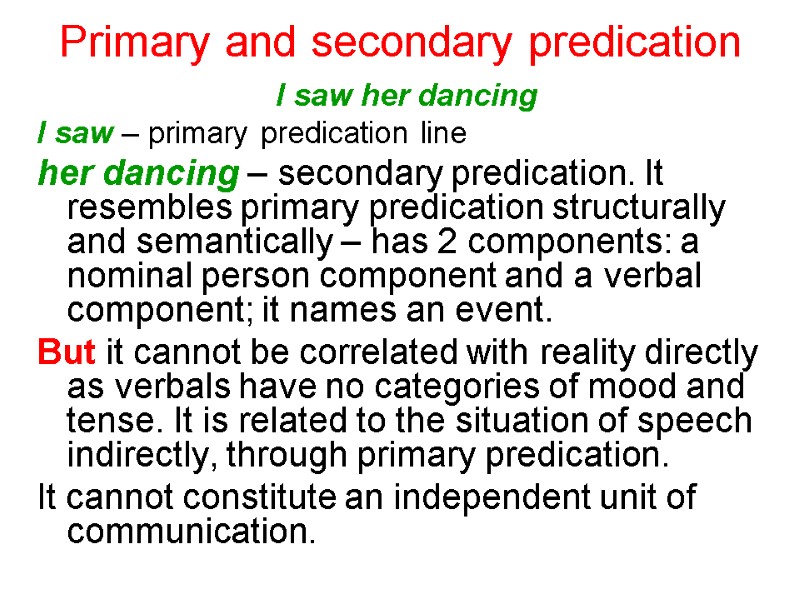
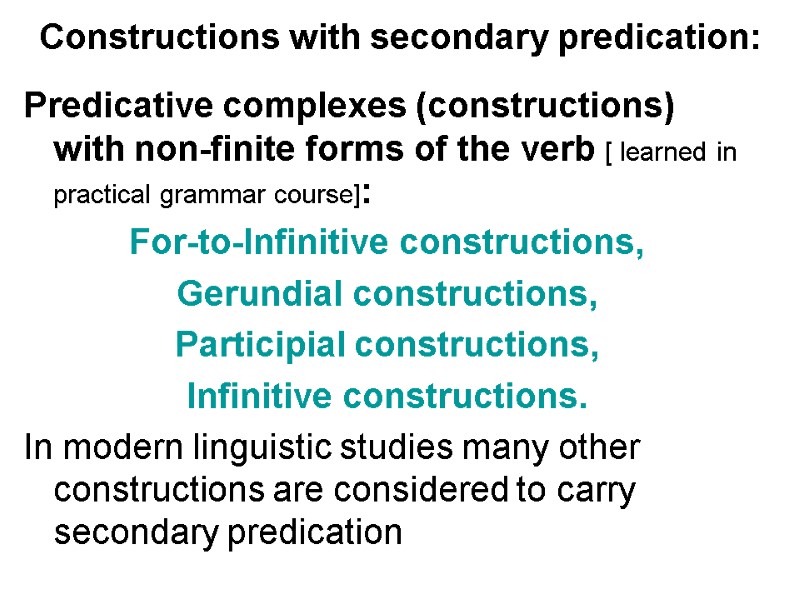
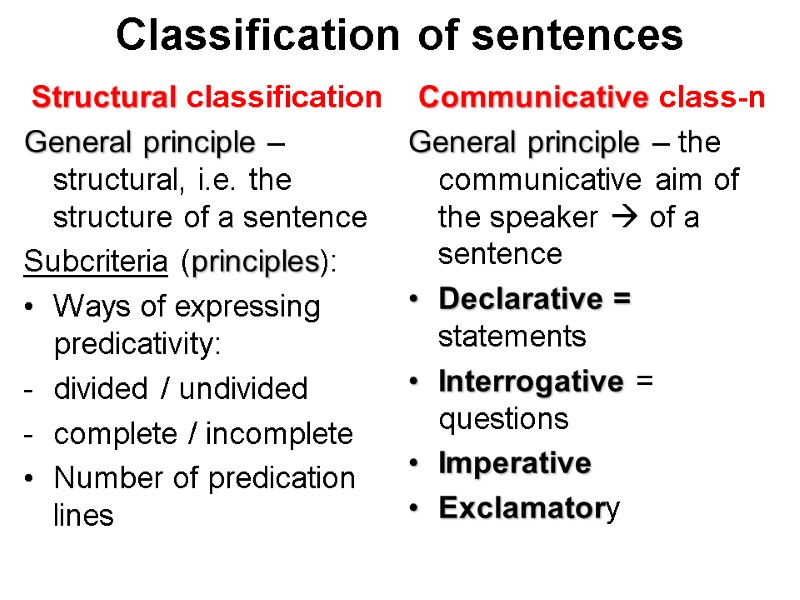
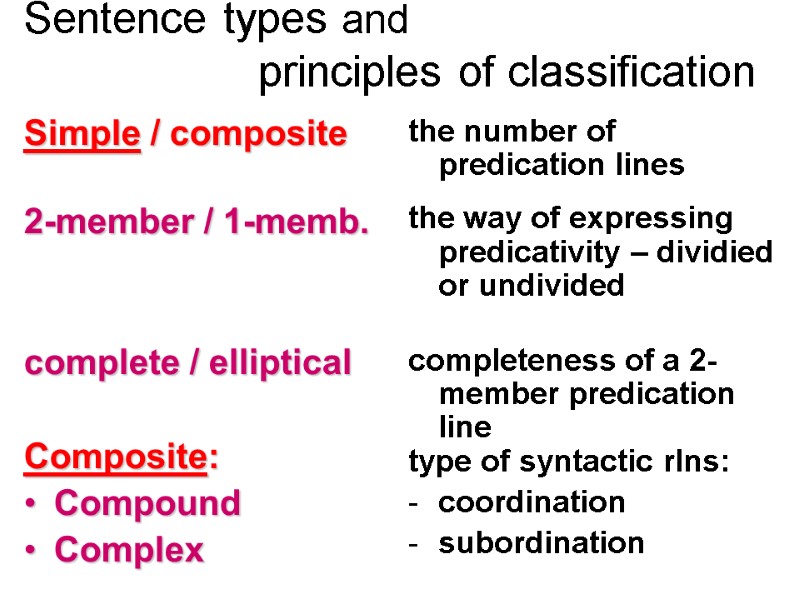
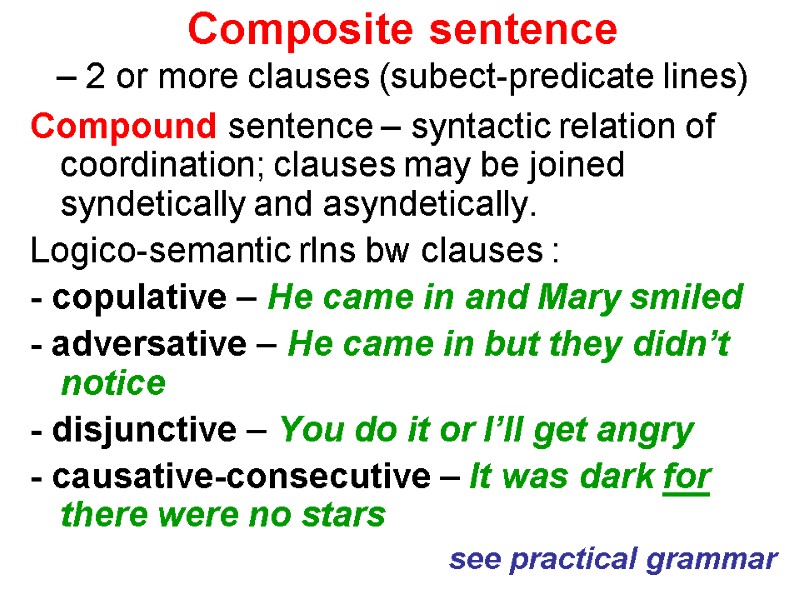
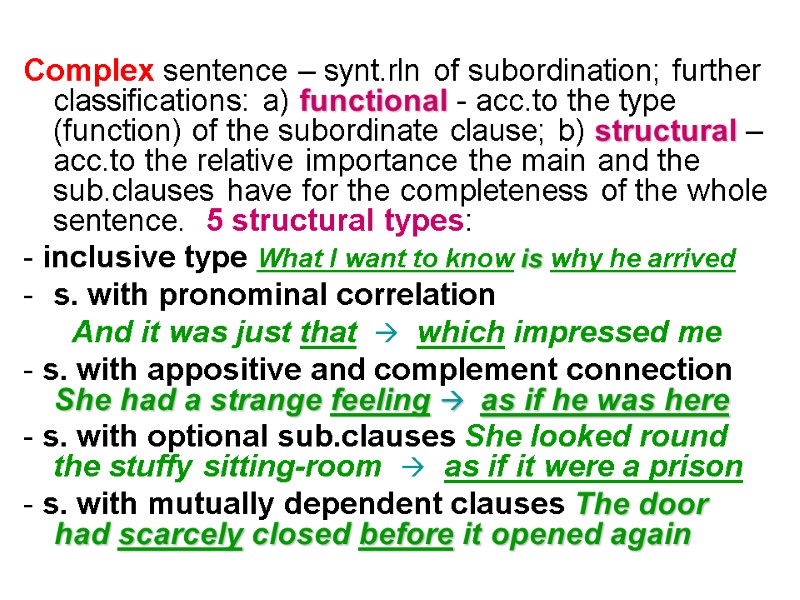
7440-state_exams_zo.ppt
- Количество слайдов: 55
 Theory of English Grammar synopsis Final examinations © И.В.Дмитриева
Theory of English Grammar synopsis Final examinations © И.В.Дмитриева
 QN 1 MAIN UNITS AND NOTIONS OF GRAMMAR
QN 1 MAIN UNITS AND NOTIONS OF GRAMMAR
 GRAMMAR is a subsystem in language which expresses meanings through the opposition of variants of one and the same unit (forms). Grammar as a linguistic discipline: Morphology + Syntax
GRAMMAR is a subsystem in language which expresses meanings through the opposition of variants of one and the same unit (forms). Grammar as a linguistic discipline: Morphology + Syntax
 Units of grammar Morpheme - form-building morphemes / inflections asks, oxen. Types of morphemes: 1- lexical, lexico-grammatical, grammatical; 2- free, bound, semi-bound, discountinuous; NB! – zero morpheme = meaningful absence Word Word group / phrase Sentence Units larger than a sentence - supraphrasal unities / etc. / texts HIERARCHY
Units of grammar Morpheme - form-building morphemes / inflections asks, oxen. Types of morphemes: 1- lexical, lexico-grammatical, grammatical; 2- free, bound, semi-bound, discountinuous; NB! – zero morpheme = meaningful absence Word Word group / phrase Sentence Units larger than a sentence - supraphrasal unities / etc. / texts HIERARCHY
 Relations Paradigmatic rlns – bw units in language 1) bw classes of lge units of a similar structural type or having similar elements. E.g. bw wd-forms of one categorial line – asking, making, doing, etc. OR 2) bw categorial forms of one unit – asks, asked, has asked, was asked, etc. - paradigm Syntagmatic rlns – bw units in speech, linear rlns e.g. bw wds in a sentence: Tom ↔ saw ↔ Mary; bw morphemes within a wd: ask- and –ing in asking; bw phonemes within a morpheme: [a:] [s] [k] in ask; Syntagmatic connection bw wds & wd groups is called syntactic rlns. (L.S.Barkhudarov)
Relations Paradigmatic rlns – bw units in language 1) bw classes of lge units of a similar structural type or having similar elements. E.g. bw wd-forms of one categorial line – asking, making, doing, etc. OR 2) bw categorial forms of one unit – asks, asked, has asked, was asked, etc. - paradigm Syntagmatic rlns – bw units in speech, linear rlns e.g. bw wds in a sentence: Tom ↔ saw ↔ Mary; bw morphemes within a wd: ask- and –ing in asking; bw phonemes within a morpheme: [a:] [s] [k] in ask; Syntagmatic connection bw wds & wd groups is called syntactic rlns. (L.S.Barkhudarov)
 PARTS OF GRAMMAR Morphology studies paradigmatic relations of words: - gram. forms making up gram. categories typical of a given part of speech - means of grammatical wd-changing (form-building morphemes) types of gram.mnings etc. Syntax studies syntagmatic relations of words and paradigmatic and syntagmatic relations of sentences
PARTS OF GRAMMAR Morphology studies paradigmatic relations of words: - gram. forms making up gram. categories typical of a given part of speech - means of grammatical wd-changing (form-building morphemes) types of gram.mnings etc. Syntax studies syntagmatic relations of words and paradigmatic and syntagmatic relations of sentences
 MAIN NOTIONS OF GRAMMAR GRAM. MEANING GRAM. FORM GRAM. CATEGORY
MAIN NOTIONS OF GRAMMAR GRAM. MEANING GRAM. FORM GRAM. CATEGORY
 Grammatical meaning = the plane of content - abstract - general - indirect obligatory relative / oppositional ask – asked gr.mning of time: present - past must has no gr.mning of time
Grammatical meaning = the plane of content - abstract - general - indirect obligatory relative / oppositional ask – asked gr.mning of time: present - past must has no gr.mning of time
 Grammatical form = the plane of expression GRAMMATICAL MORPHOLOGICAL FORM = “forms” Means of form-building: Inflections Sound interchange Suppletivity Analytical forms GRAMMATICAL SYNTACTIC FORM = distribution e.g. adj.+ noun verb + adverb ------------------------------- Distribution – a set of all possible environments of a unit
Grammatical form = the plane of expression GRAMMATICAL MORPHOLOGICAL FORM = “forms” Means of form-building: Inflections Sound interchange Suppletivity Analytical forms GRAMMATICAL SYNTACTIC FORM = distribution e.g. adj.+ noun verb + adverb ------------------------------- Distribution – a set of all possible environments of a unit
 gram. meaning ↔ gram. form there is no direct correspondence 2 or more units of the plane of expression may correspond to 1 unit of the plane of content e.g. boys – children [different gram forms – one gram mning ] 2 or more units of the plane of content may correspond to 1 unit of the plane of expression polysemy, homonymy e.g. – s inflection: boy’s, dogs, asks, greens
gram. meaning ↔ gram. form there is no direct correspondence 2 or more units of the plane of expression may correspond to 1 unit of the plane of content e.g. boys – children [different gram forms – one gram mning ] 2 or more units of the plane of content may correspond to 1 unit of the plane of expression polysemy, homonymy e.g. – s inflection: boy’s, dogs, asks, greens
 Grammatical category is a generalized grammatical meaning realized through formal and meaningful opposition of variants of one and the same unit (i.e. grammatical forms) is revealed by the method of opposition
Grammatical category is a generalized grammatical meaning realized through formal and meaningful opposition of variants of one and the same unit (i.e. grammatical forms) is revealed by the method of opposition
 Method of opposition – A.I.Smirnitskiy partially similar elements, i.e. elements having common and distinctive features, constitute an opposition, the members of which differ in form and in meaning: dog – dogs common – one wd, both forms have the mning of quantity; distinctive – diff. gram.forms & diff. mnings of quantity/number: oneness – more than oneness
Method of opposition – A.I.Smirnitskiy partially similar elements, i.e. elements having common and distinctive features, constitute an opposition, the members of which differ in form and in meaning: dog – dogs common – one wd, both forms have the mning of quantity; distinctive – diff. gram.forms & diff. mnings of quantity/number: oneness – more than oneness
 Types of oppositions acc. to the number of members (elements): binary - 2 ternary - 3 quaternary - 4 qualitatively: privative ask -- - asked+ equipollent am+ - is+ gradual good – better - best
Types of oppositions acc. to the number of members (elements): binary - 2 ternary - 3 quaternary - 4 qualitatively: privative ask -- - asked+ equipollent am+ - is+ gradual good – better - best
 Qn 2 Problems of part-of-speech classification in modern English
Qn 2 Problems of part-of-speech classification in modern English
 3 or 5 ?
3 or 5 ?
 . A part of speech is a grammatically relevant set / class of words which is specified on the basis of grammatical, semantic and lexical properties. Parts of speech are lexico-grammatical categories Function – syntactico-distributional cr. – is leading for the E. lge because of …
. A part of speech is a grammatically relevant set / class of words which is specified on the basis of grammatical, semantic and lexical properties. Parts of speech are lexico-grammatical categories Function – syntactico-distributional cr. – is leading for the E. lge because of …
 A part of speech as a field structure Pts of sp. are heterogeneous sets with fuzzy boundaries A field: - central nucleus elements - marginal peripheral elements Marginal elements of different parts of speech may ‘overlap’
A part of speech as a field structure Pts of sp. are heterogeneous sets with fuzzy boundaries A field: - central nucleus elements - marginal peripheral elements Marginal elements of different parts of speech may ‘overlap’
 e.g. of a Field structure substantivized adjectives - the wise, the cold adjectivized nouns – stone wall N Adj N Adj
e.g. of a Field structure substantivized adjectives - the wise, the cold adjectivized nouns – stone wall N Adj N Adj
 One-criterion classifications Morphological e.g. H.Sweet: declinable wds: Noun-wds, Adjective-wds, Verbs indeclinable wds termed ‘particles’ Otto Jespersen ~ Morph.cr. is not reliable bcs Syntactico-distributional Charles Fries [fri:z] ‘each class of words is characterized by a set of positions in a sentence’ substitution testing 4 classes of form wds function wds (154)
One-criterion classifications Morphological e.g. H.Sweet: declinable wds: Noun-wds, Adjective-wds, Verbs indeclinable wds termed ‘particles’ Otto Jespersen ~ Morph.cr. is not reliable bcs Syntactico-distributional Charles Fries [fri:z] ‘each class of words is characterized by a set of positions in a sentence’ substitution testing 4 classes of form wds function wds (154)
 Notional and functional wds criteria for differentiating: 1) the ‘prominence’ of their lexical mning 2) peculiarities of their combinability 3) ability to be substituted by a wd of a more general mning 4) ability to add / create new items
Notional and functional wds criteria for differentiating: 1) the ‘prominence’ of their lexical mning 2) peculiarities of their combinability 3) ability to be substituted by a wd of a more general mning 4) ability to add / create new items
 Notional and functional wds Notional wds 1) complete nominative mng 2) - self-dependent fns - can be used in isolation 3) can be substituted by a wd of a more general mng 4) open classes Functional wds 1) incomplete nominative force 2) - non-self-dependent mediatory fns: linking or specifying - obligatory combinability 3) cannot be substituted 4) closed classes
Notional and functional wds Notional wds 1) complete nominative mng 2) - self-dependent fns - can be used in isolation 3) can be substituted by a wd of a more general mng 4) open classes Functional wds 1) incomplete nominative force 2) - non-self-dependent mediatory fns: linking or specifying - obligatory combinability 3) cannot be substituted 4) closed classes
 There’s no direct correlation bw division into p.of sp. and into notional & functional wds – still… Notional wds Nouns Verbs Adjectives Adverbs ------------------------------- There may be groups of closed-system items within an open class – e.g. functional & auxiliary vs notional VERBS Functional wds Prepositions Conjunctions Articles - ?!!! Particles ------------------------------------ Pronouns take an intermediary psn bw notional & fnal wds Numerals
There’s no direct correlation bw division into p.of sp. and into notional & functional wds – still… Notional wds Nouns Verbs Adjectives Adverbs ------------------------------- There may be groups of closed-system items within an open class – e.g. functional & auxiliary vs notional VERBS Functional wds Prepositions Conjunctions Articles - ?!!! Particles ------------------------------------ Pronouns take an intermediary psn bw notional & fnal wds Numerals
 Qn 5 GRAMMATICAL CHARACTERISTICS OF THE NOUN
Qn 5 GRAMMATICAL CHARACTERISTICS OF THE NOUN
 The noun as a part of speech I. SEMANTIC – part of speech meaning of substance II. FORMAL: - typical categorial forms Inflectional – the category of number; the c. of case; the c. of gender; the c. of article determination Derivational – typical wd-blding patterns: suffixation, compounding, conversion III. FUNCTIONAL: combinability: left-hand prepositional c. with another N / V / Adj./ Adv – [ __+prep.N]; casal c. [N’s+N]; contact c. [N+N] – stone-wall constructions; c. with articles & other determiners [art./det.+N] syntactic fn – subject, object; other fns are less typical
The noun as a part of speech I. SEMANTIC – part of speech meaning of substance II. FORMAL: - typical categorial forms Inflectional – the category of number; the c. of case; the c. of gender; the c. of article determination Derivational – typical wd-blding patterns: suffixation, compounding, conversion III. FUNCTIONAL: combinability: left-hand prepositional c. with another N / V / Adj./ Adv – [ __+prep.N]; casal c. [N’s+N]; contact c. [N+N] – stone-wall constructions; c. with articles & other determiners [art./det.+N] syntactic fn – subject, object; other fns are less typical
 the morph. category of NUMBER Foundation is laid by: discreteness – non-discreteness Form: the c. of N. is constituted by the inflectional opposition of 2 categorial forms: Sg– - Pl+ dog – – dogs+ Meaning: of the category: number, quantity; of the categorial forms (members of the opposition): oneness – more than oneness
the morph. category of NUMBER Foundation is laid by: discreteness – non-discreteness Form: the c. of N. is constituted by the inflectional opposition of 2 categorial forms: Sg– - Pl+ dog – – dogs+ Meaning: of the category: number, quantity; of the categorial forms (members of the opposition): oneness – more than oneness
 The category of CASE Form – opposition the c. of Case is constituted by the inflectional opposition of 2 categorial forms: Common C. – – Possessive/Genitive+ boy – – boy’s+ boys – – boys’ + The strong member is marked by the [s], [z], [iz] allomorphs. It is distinguished in the sg, only few nouns have a marked case form in the pl. – men’s.
The category of CASE Form – opposition the c. of Case is constituted by the inflectional opposition of 2 categorial forms: Common C. – – Possessive/Genitive+ boy – – boy’s+ boys – – boys’ + The strong member is marked by the [s], [z], [iz] allomorphs. It is distinguished in the sg, only few nouns have a marked case form in the pl. – men’s.
 Meaning – rlns bw wds in the sentence: The genitive form renders a variety of mnings: - possessiveness – the boy’s dog - subjective gen. – the boy’s answer - objective gen. – the boy’s punishment - gen. of origin – the boy’s letter - quantitative (of measure) – an hour’s drive - qualitative (descriptive) – a women’s college The unmarked member of the case opposition has a very vague & indefinite mning.
Meaning – rlns bw wds in the sentence: The genitive form renders a variety of mnings: - possessiveness – the boy’s dog - subjective gen. – the boy’s answer - objective gen. – the boy’s punishment - gen. of origin – the boy’s letter - quantitative (of measure) – an hour’s drive - qualitative (descriptive) – a women’s college The unmarked member of the case opposition has a very vague & indefinite mning.
 Case theories Limited case theory – Otto Jespersen, H.Sweet, Л.С.Бархударов, А.И.Смирницкий Positional c.th. – M.Bryant, J.C.Nesfield Prepositional c.th. – G.Curm Post-positional c.th. – Воронцова, Мухин, Аракин, Кобрина ~ ‘-s’ inflection is not a typical inflection bcs… Limitative c.th. – V.Ja.Plotkin ~ ‘ limitation of the scope of reference’
Case theories Limited case theory – Otto Jespersen, H.Sweet, Л.С.Бархударов, А.И.Смирницкий Positional c.th. – M.Bryant, J.C.Nesfield Prepositional c.th. – G.Curm Post-positional c.th. – Воронцова, Мухин, Аракин, Кобрина ~ ‘-s’ inflection is not a typical inflection bcs… Limitative c.th. – V.Ja.Plotkin ~ ‘ limitation of the scope of reference’
 The c. of DETERMINATION Many scholars recognize the semantic category of article determination which marks some referents as definite & some as indefinite. A reason for specifying this category – cases of ‘meaningful absence of the article’. Only the absence of a grammatical unit may be ‘meaningful’ the article is not a lexical unit (word) but a grammatical marker.
The c. of DETERMINATION Many scholars recognize the semantic category of article determination which marks some referents as definite & some as indefinite. A reason for specifying this category – cases of ‘meaningful absence of the article’. Only the absence of a grammatical unit may be ‘meaningful’ the article is not a lexical unit (word) but a grammatical marker.
 The c. of GENDER has no grammatical morphological marking in ME. There are no oppositions of gram. forms. Few nouns have word-blding suffixes (lexical-!) that mark them as feminine or masculine: actor – actress tiger - tigress
The c. of GENDER has no grammatical morphological marking in ME. There are no oppositions of gram. forms. Few nouns have word-blding suffixes (lexical-!) that mark them as feminine or masculine: actor – actress tiger - tigress
 Qn 3 Grammatical categories denoting time and character of action ------------------------------------------------------------- the categories of TENSE, PROSPECT, ASPECT, ORDER
Qn 3 Grammatical categories denoting time and character of action ------------------------------------------------------------- the categories of TENSE, PROSPECT, ASPECT, ORDER
 Temporal relations in ME are expressed by 3 catgs: tense – present – past+ – absolutely – proper only to finite forms of the verb a predicative category prospect – non-future – future+ – abs. or rel-ly order - non-perfect – perfect + – relatively In R. temporal rlns are expressed by 1 c. of tense which denotes time both absolutely & relatively The character of action in ME is expressed by 2 categories: aspect – non-continuous – continuous+ order – non-perfect – perfect + In R. the correlated mnings are expressed lexicaly.
Temporal relations in ME are expressed by 3 catgs: tense – present – past+ – absolutely – proper only to finite forms of the verb a predicative category prospect – non-future – future+ – abs. or rel-ly order - non-perfect – perfect + – relatively In R. temporal rlns are expressed by 1 c. of tense which denotes time both absolutely & relatively The character of action in ME is expressed by 2 categories: aspect – non-continuous – continuous+ order – non-perfect – perfect + In R. the correlated mnings are expressed lexicaly.
 Qn 6 Syntactically bound morphological categories ----------------------------------------------- the categories of Voice, Mood (Representation/Finitude)
Qn 6 Syntactically bound morphological categories ----------------------------------------------- the categories of Voice, Mood (Representation/Finitude)
 The cat.of Voice denotes the direction of an action Active voice: Subject object Tom opened the door Syntactic subject (подлежащее) = Semantic subject (субъект-деятель) Obligatory combinability with the subject (субъект) of an action. Passive voice: Object The door was opened
The cat.of Voice denotes the direction of an action Active voice: Subject object Tom opened the door Syntactic subject (подлежащее) = Semantic subject (субъект-деятель) Obligatory combinability with the subject (субъект) of an action. Passive voice: Object The door was opened
 The c.of Voice is revealed through a binary opposition: active v.- passive v. opened – – was opened + But some scholars… 1. Reflexive voice Tom cut meat – Tom cut himself S O active S=O ?!? 2. Reciprocal v. They greeted Tom – They greeted each other S O active S1 S2 ?!? 3. Middle v. The door opened no direction! These are not special gram. forms of the verb! there are no such morphological ‘voices’.
The c.of Voice is revealed through a binary opposition: active v.- passive v. opened – – was opened + But some scholars… 1. Reflexive voice Tom cut meat – Tom cut himself S O active S=O ?!? 2. Reciprocal v. They greeted Tom – They greeted each other S O active S1 S2 ?!? 3. Middle v. The door opened no direction! These are not special gram. forms of the verb! there are no such morphological ‘voices’.
 The cat.of Mood indicates the relation of the contents of the utterance to reality [~modality] as stated grammatically by the speaker. The action of the utterance may be presented as: Real fact – problematic – imaginary non-fact The opposition is constituted by 1set of forms denoting facts and 2 sets of forms denoting non-facts. Only finite forms of the verb! the Indicative Md – the Imperative Md – Oblique Mds The cat.of Mood is revealed both in the opposition of forms and syntactic structures. I knew it – I wish I knew it I open the window – __ Open the window
The cat.of Mood indicates the relation of the contents of the utterance to reality [~modality] as stated grammatically by the speaker. The action of the utterance may be presented as: Real fact – problematic – imaginary non-fact The opposition is constituted by 1set of forms denoting facts and 2 sets of forms denoting non-facts. Only finite forms of the verb! the Indicative Md – the Imperative Md – Oblique Mds The cat.of Mood is revealed both in the opposition of forms and syntactic structures. I knew it – I wish I knew it I open the window – __ Open the window
 Qn 6 Syntactic relations of words. Phrases ------------------------------------------------ word-groups / free word combinations
Qn 6 Syntactic relations of words. Phrases ------------------------------------------------ word-groups / free word combinations
 (a free word combination) ~~ is a syntagmatic grouping of 2 or more wds
(a free word combination) ~~ is a syntagmatic grouping of 2 or more wds
 word combinations free wd combinations “phrases” are units of syntax If we use other words, grammatical meaning stays the same blue sky Adj+N very beautiful Adv+Adj analytical forms of a wd are units of morphology – morphological forms of a wd; they present the wd’s categorial forms have done more beautiful
word combinations free wd combinations “phrases” are units of syntax If we use other words, grammatical meaning stays the same blue sky Adj+N very beautiful Adv+Adj analytical forms of a wd are units of morphology – morphological forms of a wd; they present the wd’s categorial forms have done more beautiful
 Classification criteria by their inner structure: syntactic relations bw the components morphological expression of the components position, order, arrangement of the components by their external functioning: function of the whole phrase & its components distribution -------------------------------- distribution is a set of all possible environments of a unit
Classification criteria by their inner structure: syntactic relations bw the components morphological expression of the components position, order, arrangement of the components by their external functioning: function of the whole phrase & its components distribution -------------------------------- distribution is a set of all possible environments of a unit
 Henry Sweet – distinguished the rlns of subordination & coordination … Otto Jespersen – theory of 3 ranks: junction (attributive rlns,~ subordination) & nexus (~ interdependence) Leonard Bloomfield – distinguished endocentric (headed, ~ subordination ) & exocentric (non-headed) phrases
Henry Sweet – distinguished the rlns of subordination & coordination … Otto Jespersen – theory of 3 ranks: junction (attributive rlns,~ subordination) & nexus (~ interdependence) Leonard Bloomfield – distinguished endocentric (headed, ~ subordination ) & exocentric (non-headed) phrases
 Syntactic relations between the constituents of a phrase elements are equal elements are not equal in rank coordination subordination interdependence come and go blue sky the train arrives adjunct + kernel modifier + modified
Syntactic relations between the constituents of a phrase elements are equal elements are not equal in rank coordination subordination interdependence come and go blue sky the train arrives adjunct + kernel modifier + modified
 Syntactic rltns and types of phrases coordination – coordinate phrase – further clssn goes according to the morphological expression of the constituents : e.g. come and go - V+V - it is a coordinate verb phrase subordination – subordinate phrase – further clssn goes according to the morphological expression of the kernel : e.g. blue sky – the kernel is sky so it is a subordinate noun phrase NB! – appositive phrases e.g. the city of Minsk, king Alfred interdependence ~ predication – interdependent phrase (!?!)
Syntactic rltns and types of phrases coordination – coordinate phrase – further clssn goes according to the morphological expression of the constituents : e.g. come and go - V+V - it is a coordinate verb phrase subordination – subordinate phrase – further clssn goes according to the morphological expression of the kernel : e.g. blue sky – the kernel is sky so it is a subordinate noun phrase NB! – appositive phrases e.g. the city of Minsk, king Alfred interdependence ~ predication – interdependent phrase (!?!)
 Means of expressing syntactic relations Word order cannon ball N+N Prepositions the category of aspect Conjunctions warm and nice Adj+Adj Case inflection -‘s Bob’s car N’s+N Morphological expression of the components speak softly V+Adv
Means of expressing syntactic relations Word order cannon ball N+N Prepositions the category of aspect Conjunctions warm and nice Adj+Adj Case inflection -‘s Bob’s car N’s+N Morphological expression of the components speak softly V+Adv
 Qn 7 Sentence as the main unit of syntax. (Predicativity. Classes of sentences.)
Qn 7 Sentence as the main unit of syntax. (Predicativity. Classes of sentences.)
 THE SENTENCE is the immediate integral unit of speech built according to a definite syntactic pattern and distinguished by a contextually relevant communicative purpose (M.J.Blokh) Members of the sentence – see practical grammar It has 2 basic fns: naming and communicative. It can perform the communicative fn because it possesses the property known as predicativity.
THE SENTENCE is the immediate integral unit of speech built according to a definite syntactic pattern and distinguished by a contextually relevant communicative purpose (M.J.Blokh) Members of the sentence – see practical grammar It has 2 basic fns: naming and communicative. It can perform the communicative fn because it possesses the property known as predicativity.
 Predicativity is the correlation of what is named by the sentence with the situation of speech.
Predicativity is the correlation of what is named by the sentence with the situation of speech.
 Predicativity is constituted by 3 components: Modality the category of mood – Pr.Verb Time the category of tense – Pr.Verb Person the category of person – Pr.Verb \ Subject The boy laughed out loudly So the Predicate Verb is the main means of expressing predicativity. The Subject is involved in expressing the person component of predicativity.
Predicativity is constituted by 3 components: Modality the category of mood – Pr.Verb Time the category of tense – Pr.Verb Person the category of person – Pr.Verb \ Subject The boy laughed out loudly So the Predicate Verb is the main means of expressing predicativity. The Subject is involved in expressing the person component of predicativity.
 The means of expressing predicativity is Predication In some sentences it is presented undivided – these are one-member sentences (see. practical gr.) – Night. A cry. A flash of light. In most sentences it is presented as a divided structure – a subject-predicate group. These are two-member sentences. – The sun is shining. The subject-predicate line = predication line A sentence may contain primary and secondary predication
The means of expressing predicativity is Predication In some sentences it is presented undivided – these are one-member sentences (see. practical gr.) – Night. A cry. A flash of light. In most sentences it is presented as a divided structure – a subject-predicate group. These are two-member sentences. – The sun is shining. The subject-predicate line = predication line A sentence may contain primary and secondary predication
 Primary and secondary predication I saw her dancing I saw – primary predication line her dancing – secondary predication. It resembles primary predication structurally and semantically – has 2 components: a nominal person component and a verbal component; it names an event. But it cannot be correlated with reality directly as verbals have no categories of mood and tense. It is related to the situation of speech indirectly, through primary predication. It cannot constitute an independent unit of communication.
Primary and secondary predication I saw her dancing I saw – primary predication line her dancing – secondary predication. It resembles primary predication structurally and semantically – has 2 components: a nominal person component and a verbal component; it names an event. But it cannot be correlated with reality directly as verbals have no categories of mood and tense. It is related to the situation of speech indirectly, through primary predication. It cannot constitute an independent unit of communication.
 Constructions with secondary predication: Predicative complexes (constructions) with non-finite forms of the verb [ learned in practical grammar course]: For-to-Infinitive constructions, Gerundial constructions, Participial constructions, Infinitive constructions. In modern linguistic studies many other constructions are considered to carry secondary predication
Constructions with secondary predication: Predicative complexes (constructions) with non-finite forms of the verb [ learned in practical grammar course]: For-to-Infinitive constructions, Gerundial constructions, Participial constructions, Infinitive constructions. In modern linguistic studies many other constructions are considered to carry secondary predication
 Classification of sentences Structural classification General principle – structural, i.e. the structure of a sentence Subcriteria (principles): Ways of expressing predicativity: divided / undivided complete / incomplete Number of predication lines Communicative class-n General principle – the communicative aim of the speaker of a sentence Declarative = statements Interrogative = questions Imperative Exclamatory
Classification of sentences Structural classification General principle – structural, i.e. the structure of a sentence Subcriteria (principles): Ways of expressing predicativity: divided / undivided complete / incomplete Number of predication lines Communicative class-n General principle – the communicative aim of the speaker of a sentence Declarative = statements Interrogative = questions Imperative Exclamatory
 Sentence types and principles of classification Simple / composite 2-member / 1-memb. complete / elliptical Composite: Compound Complex the number of predication lines the way of expressing predicativity – dividied or undivided completeness of a 2-member predication line type of syntactic rlns: coordination subordination
Sentence types and principles of classification Simple / composite 2-member / 1-memb. complete / elliptical Composite: Compound Complex the number of predication lines the way of expressing predicativity – dividied or undivided completeness of a 2-member predication line type of syntactic rlns: coordination subordination
 Composite sentence – 2 or more clauses (subect-predicate lines) Compound sentence – syntactic relation of coordination; clauses may be joined syndetically and asyndetically. Logico-semantic rlns bw clauses : - copulative – He came in and Mary smiled - adversative – He came in but they didn’t notice - disjunctive – You do it or I’ll get angry - causative-consecutive – It was dark for there were no stars see practical grammar
Composite sentence – 2 or more clauses (subect-predicate lines) Compound sentence – syntactic relation of coordination; clauses may be joined syndetically and asyndetically. Logico-semantic rlns bw clauses : - copulative – He came in and Mary smiled - adversative – He came in but they didn’t notice - disjunctive – You do it or I’ll get angry - causative-consecutive – It was dark for there were no stars see practical grammar
 Complex sentence – synt.rln of subordination; further classifications: a) functional - acc.to the type (function) of the subordinate clause; b) structural – acc.to the relative importance the main and the sub.clauses have for the completeness of the whole sentence. 5 structural types: - inclusive type What I want to know is why he arrived s. with pronominal correlation And it was just that which impressed me - s. with appositive and complement connection She had a strange feeling as if he was here - s. with optional sub.clauses She looked round the stuffy sitting-room as if it were a prison - s. with mutually dependent clauses The door had scarcely closed before it opened again
Complex sentence – synt.rln of subordination; further classifications: a) functional - acc.to the type (function) of the subordinate clause; b) structural – acc.to the relative importance the main and the sub.clauses have for the completeness of the whole sentence. 5 structural types: - inclusive type What I want to know is why he arrived s. with pronominal correlation And it was just that which impressed me - s. with appositive and complement connection She had a strange feeling as if he was here - s. with optional sub.clauses She looked round the stuffy sitting-room as if it were a prison - s. with mutually dependent clauses The door had scarcely closed before it opened again

